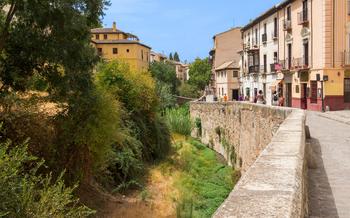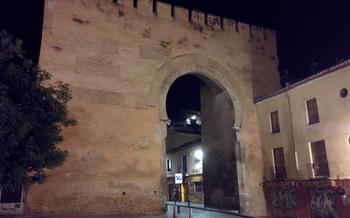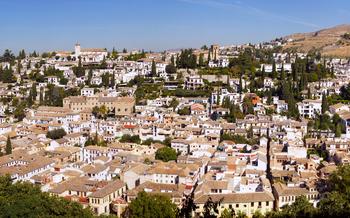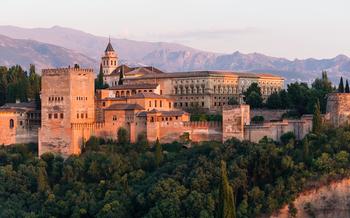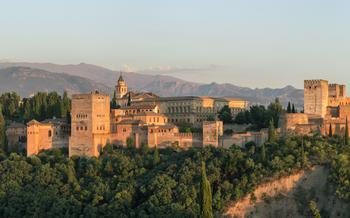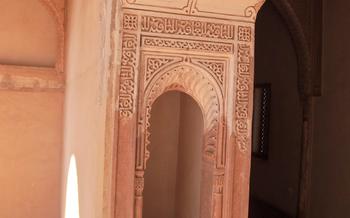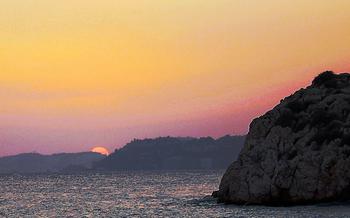
Carmen de los Mártires
- Historical Background
- Main Attractions
- Granada's Hidden Gem
- The Monuments
- The Views
- The Events
- The Serenity
- The History of the Convent
- The Restoration of the Park
- The Gardens of the World
- The "Carmen" in Literature
- The Garden of Poets
- Insider Tip:
Historical Background
The Carmen de los Mártires is a historical park located in the heart of Granada, Spain. Its origins can be traced back to the 16th century, when it was established as a convent for the Order of Discalced Carmelites. Over the centuries, the convent underwent several renovations and expansions, reflecting the changing architectural styles and tastes of the period. In the 19th century, the convent was abandoned and fell into disrepair. In the early 20th century, the site was acquired by the city of Granada and transformed into a public park, restoring its former glory and preserving its rich cultural heritage.
The Carmen de los Mártires stands as a testament to Granada's rich history and cultural diversity. Its architectural styles blend Gothic, Renaissance, and Baroque elements, showcasing the city's architectural evolution over the centuries. As a public park, it has become a beloved destination for locals and tourists alike, offering a tranquil oasis amidst the vibrant urban landscape.
Main Attractions
The Carmen de los Mártires is a treasure trove of natural and cultural wonders. Its verdant gardens, adorned with a diverse array of plant life, provide a feast for the eyes. Visitors can stroll along winding paths, admiring the vibrant colors and fragrant blooms of roses, jasmine, and bougainvillea. The park also boasts an impressive collection of trees, including centuries-old olive trees, towering cypresses, and majestic pines.
Amidst the lush greenery, visitors will encounter a series of captivating fountains, each adorned with intricate carvings and spouting refreshing jets of water. The Lion Fountain, with its majestic lion sculptures, is a particularly striking sight. The park's monuments are equally impressive, showcasing a blend of architectural styles and historical significance. The Monument to the Martyrs, dedicated to those who lost their lives in the defense of Granada, stands as a poignant reminder of the city's past.
The Gloriette, a charming gazebo perched atop a hill, offers breathtaking panoramic views of the city and the surrounding mountains. It is the perfect spot to sit and soak in the beauty of Granada while enjoying a picnic or simply relishing the tranquility of the surroundings.
Granada's Hidden Gem
The Carmen de los Mártires is often overlooked by tourists, making it a hidden gem among Granada's many attractions. While the Alhambra and the Albaicín neighborhood receive the lion's share of attention, the Carmen de los Mártires offers a unique and tranquil experience that should not be missed.
Unlike the bustling city center, the Carmen de los Mártires exudes a serene and peaceful atmosphere. Its lush gardens, tranquil fountains, and historic monuments provide a welcome respite from the hustle and bustle of urban life. Visitors can wander through the park at their leisure, taking in the beauty of their surroundings and enjoying the sounds of nature.
The park's secluded location, just a short walk from the city center, adds to its charm. Nestled on the slopes of the Alhambra hill, the Carmen de los Mártires offers stunning views of the city and the surrounding mountains. It is the perfect place to escape the crowds and enjoy a moment of tranquility and reflection.
The Monuments
The Carmen de los Mártires is home to several notable monuments that add to its historical and cultural significance. Among the most prominent is the Monument to the Martyrs, a poignant tribute to the Christian martyrs who were persecuted during the Moorish rule of Granada. The monument features a bronze statue of a martyr standing atop a pedestal, surrounded by four marble plaques depicting scenes from the martyrs' lives.
Another notable monument is the Lion Fountain, a beautiful fountain adorned with a majestic bronze lion. The fountain was originally located in the Alhambra but was later moved to the Carmen de los Mártires. The lion is depicted as roaring, symbolizing strength and courage.
The Gloriette is a charming gazebo located at the highest point of the park. It offers stunning panoramic views of the city and the surrounding mountains. The Gloriette is a popular spot for visitors to relax and enjoy the scenery.
These monuments, along with others scattered throughout the park, tell the story of Granada's rich history and are a testament to the city's cultural heritage. They add to the overall charm and beauty of the Carmen de los Mártires, making it a must-visit destination for anyone interested in exploring Granada's past.
The Views
The Carmen de los Mártires offers breathtaking panoramic views of Granada and the surrounding mountains, making it a popular spot for photography enthusiasts and nature lovers alike. One of the best viewpoints is the Mirador de San Nicolás, located at the highest point of the park. From here, visitors can enjoy stunning vistas of the Alhambra, the Sierra Nevada mountains, and the city of Granada spread out below. Another popular spot for taking in the views is the Torre de la Vela, a 14th-century watchtower located within the Alhambra complex. From the top of the tower, visitors can enjoy panoramic views of the entire city, including the Carmen de los Mártires. The views from the Carmen de los Mártires are particularly beautiful at sunset, when the sky turns a fiery red and the city lights begin to twinkle.
The Events
The Carmen de los Mártires is not only a beautiful park but also a vibrant cultural hub that hosts a wide range of events and activities throughout the year. These events showcase the park's unique atmosphere and offer visitors the opportunity to experience its cultural and historical significance in a lively and engaging way.
One of the most popular annual events is the Festival of the Crosses, held in May. During this festival, the park is adorned with colorful crosses made of flowers, creating a stunning visual display. Visitors can admire the intricate designs of the crosses, participate in traditional dances and music performances, and sample delicious local cuisine.
Another highlight is the International Jazz Festival, held in June. This festival brings together renowned jazz musicians from around the world to perform in the park's enchanting setting. Visitors can enjoy live music, relax on the grass, and soak up the vibrant atmosphere.
The Carmen de los Mártires also hosts regular concerts, art exhibitions, and literary events. These events provide a platform for local artists and performers to showcase their talents and share their passion with the community. Visitors can attend these events to experience the park's diverse cultural offerings and connect with the creative spirit of Granada.
Whether you're interested in music, art, literature, or simply want to enjoy a festive atmosphere, the Carmen de los Mártires offers a variety of events that cater to different tastes and interests. These events bring the park to life and provide visitors with unique and memorable experiences that go beyond its natural beauty.
The Serenity
The Carmen de los Mártires is a haven of tranquility in the heart of bustling Granada. As you step through its gates, you will be greeted by a serene atmosphere that envelops you like a gentle breeze. The sounds of the city fade away, replaced by the gentle rustling of leaves, the chirping of birds, and the soft murmur of water fountains.
The park's design contributes to its peaceful ambiance. Its winding paths lead you through tranquil gardens, past serene ponds, and under the shade of towering trees. The scent of flowers fills the air, creating a fragrant tapestry that enhances the sense of tranquility.
Many visitors come to the Carmen de los Mártires to escape the hustle and bustle of city life. Here, they can find a place to relax, reflect, and reconnect with nature. Whether you choose to sit on a bench and admire the views, wander through the gardens, or simply soak up the sun's warmth, the park provides the perfect setting for peaceful contemplation.
The serenity of the Carmen de los Mártires is one of its defining characteristics. It is a place where you can slow down, breathe deeply, and let go of your worries. Whether you are seeking a quiet retreat or simply a place to unwind, the park offers a sanctuary of peace and tranquility that will leave you feeling refreshed and rejuvenated.
The History of the Convent
The Carmen de los Mártires has a rich and storied history, dating back to the 16th century when it was established as a convent for the Order of Discalced Carmelites. The convent was built on the site of a former Muslim cemetery, and it quickly became an important religious and spiritual center in Granada. The Carmelite nuns who lived in the convent were known for their piety and devotion, and the convent became a popular destination for pilgrims and visitors seeking solace and guidance.
The convent flourished for several centuries, but it began to decline in the 19th century due to a combination of factors, including the Napoleonic Wars and the Spanish Civil War. In 1835, the convent was confiscated by the Spanish government and sold to a private owner. The new owner converted the convent into a private residence, and it remained in private hands until the early 20th century when it was acquired by the city of Granada.
The Restoration of the Park
In the early 20th century, the Carmen de los Mártires underwent a significant restoration project aimed at reviving its former glory and transforming it into a public park. This ambitious undertaking was driven by a desire to preserve the park's rich cultural and historical heritage while adapting it to the needs of a modern urban environment.
The restoration process involved a delicate balance between preserving the park's original features and introducing necessary upgrades to enhance its functionality and accessibility. Careful attention was paid to maintaining the park's historic charm, including the restoration of its gardens, fountains, and monuments.
One of the key challenges faced during the restoration was the need to address the park's dilapidated state. Many of the structures had fallen into disrepair, and the gardens were overgrown and neglected. The restoration team worked meticulously to repair and restore these elements, ensuring that the park's unique character was maintained.
The restoration project also involved the introduction of modern amenities to improve the park's accessibility and attractiveness. New pathways were created, lighting was installed, and seating areas were added to provide visitors with comfortable places to relax and enjoy the surroundings.
The successful restoration of the Carmen de los Mártires resulted in a revitalized public space that seamlessly blended its historic charm with modern conveniences. This transformation not only preserved the park's cultural heritage but also ensured its continued relevance and enjoyment for future generations.
The Gardens of the World
The Carmen de los Mártires is home to a unique feature known as the Gardens of the World. This section of the park showcases different gardening styles and plant species from around the globe, creating a diverse and educational experience for visitors.
The Gardens of the World are divided into several sections, each representing a different region or country. Visitors can stroll through the Japanese Garden, with its serene ponds and meticulously manicured bonsai trees; the English Garden, with its rolling lawns, colorful flower beds, and towering oak trees; and the French Garden, with its formal geometric design, intricate topiaries, and fragrant rose bushes.
The educational value of the Gardens of the World is significant. Visitors can learn about the different climates, soils, and plant species that thrive in each region. The gardens also provide insights into the cultural and historical significance of gardening in different parts of the world.
Whether you are a passionate gardener, a nature enthusiast, or simply someone who appreciates beauty, the Gardens of the World at the Carmen de los Mártires offer a unique and unforgettable experience.
The "Carmen" in Literature
The Carmen de los Mártires has played a significant role in the literary landscape of Granada, inspiring writers and poets throughout the centuries with its beauty and history. One of the most famous literary figures associated with the park is Washington Irving, who wrote about it in his book "Tales of the Alhambra." Irving's descriptions of the park's gardens, fountains, and monuments helped to popularize the Carmen de los Mártires among travelers and writers alike.
Another notable writer who was inspired by the Carmen de los Mártires was Federico García Lorca. Lorca, who was born in Granada, often visited the park and wrote about it in his poems and plays. In his play "Blood Wedding," Lorca uses the Carmen de los Mártires as a setting for a tragic love story.
The park's literary significance is further enhanced by the Garden of Poets, a special section dedicated to poets who have written about Granada. The garden features busts and plaques of poets such as Ibn al-Khatib, Lorca, and Manuel Machado, whose works celebrate the beauty and history of the city.
The Carmen de los Mártires continues to inspire writers and poets to this day, serving as a muse for creative expression and a reminder of the rich cultural heritage of Granada.
The Garden of Poets
Nestled within the tranquil embrace of the Carmen de los Mártires lies the enchanting Garden of Poets, a verdant oasis dedicated to the literary luminaries who have immortalized Granada in their verses. This serene haven pays homage to the poets whose words have captured the essence of this captivating city, weaving its rich history, vibrant culture, and breathtaking beauty into an intricate tapestry of language.
Among the illustrious figures honored in the Garden of Poets are Ibn al-Khatib, the erudite vizier and polymath of the Nasrid dynasty; Federico García Lorca, the avant-garde poet and playwright whose tragic death during the Spanish Civil War left an indelible mark on the literary landscape; and Manuel Machado, the lyrical chronicler of Andalusian life and customs.
The garden serves as a sanctuary for contemplation, where visitors can immerse themselves in the poetic musings that have shaped Granada's literary identity. Amidst the fragrant blooms and whispering trees, one can almost hear the echoes of these poets' voices, their words painting vivid pictures of Granada's vibrant streets, its majestic Alhambra, and the passionate soul of its people.
The Garden of Poets is a testament to the enduring power of literature, its ability to transcend time and capture the essence of a place in words that resonate with generations. It is a fitting tribute to the poets who have made Granada their muse, weaving its magic into the fabric of their verse.
Insider Tip:
To truly experience the essence of the Carmen de los Mártires, venture off the beaten path and seek out the hidden gems that lie within its tranquil embrace. One such gem is the secluded Rose Garden, nestled amidst a labyrinth of verdant paths. Here, amidst the vibrant tapestry of colors and heady fragrance, you can lose yourself in the beauty of nature and find solace in the embrace of tranquility. For the ultimate insider experience, time your visit to coincide with the magical hour of sunrise or sunset, when the park is bathed in a golden glow and the atmosphere is infused with a sense of serenity that will leave you breathless.
Combine your visit to the Carmen de los Mártires with a leisurely stroll through the enchanting Albaicín neighborhood, a UNESCO World Heritage site. Wander through its narrow cobbled streets, marvel at the whitewashed houses adorned with colorful flowers, and soak in the vibrant atmosphere of this historic district. The Albaicín offers a glimpse into Granada's rich past and provides a delightful contrast to the serene beauty of the Carmen de los Mártires.
